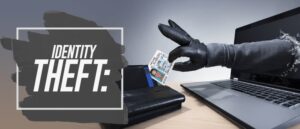Introduction
In our digital age, protecting your personal information online is more crucial than ever. Cyber security isn’t just for tech experts—it’s something we all need to be aware of. Identity theft can happen to anyone, and the consequences can be severe. In this guide, we’ll walk you through everything you need to know about identity theft, from understanding what it is to preventing it, and what steps to take if you become a victim.

Understanding Identity Theft
Identity theft occurs when someone steals your personal information, like your Social Security number or credit card details, to commit fraud. This can lead to financial loss, damaged credit, and a whole lot of stress.
Common Types of Identity Theft
- Financial Identity Theft: This is when someone uses your identity to make purchases, open credit accounts, or take out loans.
- Medical Identity Theft: In this scenario, your personal information is used to receive medical services or to claim insurance benefits.
- Criminal Identity Theft: Here, your identity is used by someone else to commit crimes, leaving you to clean up the legal mess.
Real-life Examples
Consider Jane Doe, who suddenly found herself denied for a mortgage because of a slew of unpaid credit card bills she never knew existed. Or John Smith, whose health insurance was maxed out by a stranger’s medical procedures.
How Identity Theft Happens
Identity theft can occur in several ways:
- Phishing Scams: Fraudsters send emails or messages posing as legitimate companies to steal your information.
- Data Breaches: Hackers break into company databases and steal customer information.
- Malware and Spyware: Malicious software can be installed on your devices, capturing your keystrokes and personal data.
- Social Engineering: Thieves manipulate you into revealing your personal information.
- Physical Theft of Personal Information: Lost or stolen wallets, mail, or paperwork can give thieves access to your identity.
Signs of Identity Theft
It’s crucial to recognize the signs of identity theft early:
- Unexplained charges on your accounts
- Missing mail, especially bills or statements
- Denied credit applications you didn’t apply for
- Notifications from your financial institutions about suspicious activities
Preventing Identity Theft
Preventing identity theft involves a combination of vigilance and practical steps:
- Strong, Unique Passwords: Use complex passwords for all your accounts and change them regularly.
- Two-Factor Authentication: This adds an extra layer of security by requiring a second form of verification.
- Secure Internet Connections: Avoid using public Wi-Fi for sensitive transactions; use encrypted connections instead.
- Shred Personal Documents: Dispose of documents that contain personal information properly.
- Monitor Credit Reports: Regularly check your credit reports for any suspicious activity.
Protecting Personal Information Online
Staying safe online involves more than just avoiding suspicious emails:
- Safe Social Media Practices: Be cautious about the information you share on social media. Adjust privacy settings and avoid posting personal details.
- Recognizing Secure Websites: Ensure websites are secure by looking for “https” in the URL and a padlock symbol.
- Using VPNs: Virtual Private Networks (VPNs) provide a secure connection, especially when using public Wi-Fi.
- Avoiding Public Wi-Fi for Sensitive Transactions: Public Wi-Fi networks are often not secure. Avoid accessing sensitive information while connected to them.
What to Do If Your Identity Is Stolen
If you suspect that your identity has been stolen, act quickly:
- Immediate Steps to Take:
- Contact your financial institutions to report and freeze accounts.
- Place fraud alerts with the major credit bureaus.
- File a police report to document the theft.
- Long-term Actions:
- Enroll in credit monitoring services to keep an eye on your accounts.
- Regularly update your passwords and security questions.
Recovering from Identity Theft
Recovery can be a long process, but it’s essential to restore your financial health:
- Resolving Fraudulent Transactions: Work with your bank or credit card company to dispute and remove fraudulent charges.
- Repairing Your Credit: Take steps to repair any damage to your credit score by paying off debts and correcting any errors on your credit report.
- Legal Actions and Support: Seek legal advice if necessary and take advantage of support services available to identity theft victims.
Cyber Security Tools and Resources
There are many tools and resources to help protect your identity:
- Anti-virus Software: Keep your devices secure with reliable anti-virus programs.
- Identity Theft Protection Services: Consider services that monitor your personal information and alert you to potential threats.
- Government Resources and Websites: Use government websites for up-to-date information and assistance with identity theft.
Conclusion
In today’s world, staying vigilant about cyber security and protecting your identity is a must. By taking proactive steps and knowing what to do if the worst happens, you can safeguard your personal information and reduce the risk of identity theft.
FAQs
What are the first signs of identity theft?
The first signs often include unexplained charges on your accounts, receiving bills or statements for accounts you didn’t open, and notifications from financial institutions about suspicious activities.
How can I secure my social media accounts?
Use strong, unique passwords, enable two-factor authentication, adjust your privacy settings, and be cautious about the personal information you share.
Is it safe to use public Wi-Fi?
Public Wi-Fi is generally not secure. Avoid accessing sensitive information or conducting financial transactions while connected to public Wi-Fi networks.
What should I do if my identity is stolen abroad?
Contact your financial institutions immediately, place fraud alerts with credit bureaus, file a police report locally and back home, and seek assistance from your country’s embassy or consulate.
How often should I monitor my credit report?
It’s recommended to check your credit report at least once a year. However, more frequent monitoring, like quarterly or even monthly, can help detect issues early.





